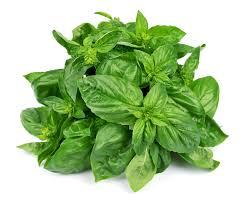Basil is one of the most popular herbs.
It’s easy to grow and tastes great in many different recipes. Several different varieties of fresh basil available now – just in time to get you through the winter!
Sweet Basil – the staple of Italian cuisine that tangos with tomatoes and perks up pesto – is the most common type of this regal herb, highly prized for thousands of years for its aroma and flavor. In fact, the word basil is derived from an ancient Greek word for royalty. While sweet basil has flat, green leaves and a somewhat minty flavor, the herb also comes in purples and reds, and some varieties feature ruffled leaves. Some basil tastes faintly of lemon, lime, or cinnamon. While some basil grows to a compact 15 inches in height, other varieties reach a leggy 5 feet.
Basil is available as small potted plants. Once the basil is planted, pinch off or clip what leaves you need to season a meal, or store a bumper crop by freezing or drying for use year-round. Basil complements everything from olive oil and hot tea, to chicken and fish, to rice and noodles, or any savory dish. It’s truly a royal herb the masses can grow and love.
GROWING BASILS –
Basil grows easily in a container on a sunny windowsill or a patch of well-drained soil in full sun. To start it from seed, plant in late spring when nights are regularly above 50 degrees, sowing seeds ½ inch deep. Seeds may also be sown in pots indoors four to six weeks before planting for earlier harvests. Place plants 12-15 inches apart. Basil languishes in cool, damp weather, but grows quickly in hot weather.
Water plants adequately, but allow the soil to become slightly dry between waterings. Fertilize by incorporating compost into the soil before planting or topdressing at planting to encourage vigorous, healthy growth. Commercially prepared fertilizers can produce too much growth at the expense of flavor.
To coax basil to branch and to slow flowering, pinch off and harvest the terminal shoots. Basil should be harvested before flower buds form, but late in the season, basil flowers can be added to salads or used as a garnish.
Because basil is a short-lived annual, replant periodically through midsummer. Potted plants can be grown in a bright, sunny window indoors for fresh basil throughout the winter.
HARVESTING AND STORING BASILS –
Keeping a few basil plants in the garden or in the house is a surefire way to bring a zing to salads, pasta, and almost any main course. Harvest basil by cutting branches or whole plants before flower buds develop. Young leaves have the best flavor; leaves harvested after flowering can be bitter. Hang the stems to dry, or pluck leaves immediately to use or store. To store basil, follow these tips:
Short-Term Storage – To keep just-picked sprigs fresh for several days, place them in a glass of water and store at room temperature, like a vase of flowers. Do not refrigerate.
Freezing – Chop four parts packed, fresh leaves with one part olive or canola oil in a food processor. Scoop the mixture into small freezer bags, label and freeze. The next time you make spaghetti sauce, break off a chunk of the frozen herb and drop it in the pot. You can use a bumper crop of basil to make fresh pesto. Just leave out the cheese if you freeze it. When you’re ready to indulge, thaw the pesto, add the cheese and serve.
Drying – Dried basil keeps for a few months, though its flavor doesn’t compare to fresh. The most volatile of the herb’s essential oils evaporates in the drying process. To dry, harvest leaves and place on a screen, or bundle two or three sprigs with a rubber band and hang them upside down to let air circulate. Keep leaves or bundled sprigs in a dark, dry room until they are completely dry and crisp. Then, depending on how fine you want the herb, crumble the leaves with your fingers, or crush with a mortar and pestle. Store dried basil in a cool place inside an airtight container.


